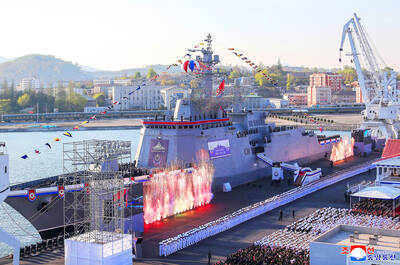The whole of sub-Saharan Africa -- the poorest region of the world -- will fail to meet the goals set seven years ago for eradicating global poverty by 2015, the UN warned yesterday.
In a progress report at the halfway point to the target date for hitting the Millennium Development Goals (MDGs), the UN said the world was failing in the battle to combat hunger, cut infant mortality and put every child in school.
"The results presented in this report suggest that there have been some gains and that success is still possible in most parts of the world," UN Secretary-General Ban Ki-moon said. "But they also point to how much remains to be done."
Aided by the economic progress in China and India, the UN said the proportion of people living on less than a dollar a day had fallen from 23.4 percent in 1999 to 19.2 percent and the world was on track to hit the 15.8 percent target for 2105. However, the 23.4 percent benchmark for Africa would not be met.
Slower progress had been made on halving the number of children under five who are underweight from the 33 percent in 1990. The percentage has come down to 27 percent, with 46 percent of under-fives in Africa registered as underweight. Infant mortality is down by one sixth, against the UN's target of a two-thirds cut.
Although the UN has a target of universal primary education, it said 30 percent of children in sub-Saharan Africa and 12 percent globally were out of school.
In health, the number of people living with AIDS had risen sixfold to 40 million since 2001, while sub-Saharan Africa was the only region in the world to see a rise in tuberculosis.
The UN study coincided with a report from the British charity WaterAid, which said attempts to hit the MDGs were being hampered by under-investment in clean water and proper sanitation.
WaterAid warned Britain and the other big donors that investment in health and education would be undermined if almost 5,000 children a day continued to die from diarrhea and miss school to fetch water.
"Global aid spending on health and education has nearly doubled since 1990 while the share allocated to water and sanitation has contracted," said Henry Northover, WaterAid's head of policy.
In recent years, donor countries have committed themselves to building schools and providing backing for health systems in poor countries in the hope that they can hit the millennium goals of putting every child into primary education and of cutting infant mortality rates by two-thirds.
In a report yesterday, WaterAid said that education, particularly that of girls, suffered in nations that lacked clean water and sanitation.
"Although rarely recognized by education policy makers, a large part of the explanation for this high dropout rate is inadequate water and sanitation," the report said.
"Girls miss school because they spend hours fetching water for their families. With the onset of puberty, they face the embarrassment of menstruation in schools where toilets are unclean, have no doors and are shared with the boys in their class," the report said.
The report added that in countries with high child mortality rates, diarrhea accounted for more deaths than any other cause -- more than pneumonia and more than malaria and HIV/AIDS combined.
"Over 90 percent of diarrheal deaths are attributed to poor hygiene, sanitation and unsafe drinking water," the report said.
So, while more than 550 million children have been vaccinated against measles since 2000, little action has been taken to prevent the daily death toll of 4,900 children afflicted with diarrhea, it said.

Archeologists in Peru on Thursday said they found the 5,000-year-old remains of a noblewoman at the sacred city of Caral, revealing the important role played by women in the oldest center of civilization in the Americas. “What has been discovered corresponds to a woman who apparently had elevated status, an elite woman,” archeologist David Palomino said. The mummy was found in Aspero, a sacred site within the city of Caral that was a garbage dump for more than 30 years until becoming an archeological site in the 1990s. Palomino said the carefully preserved remains, dating to 3,000BC, contained skin, part of the

TRUMP EFFECT: The win capped one of the most dramatic turnarounds in Canadian political history after the Conservatives had led the Liberals by more than 20 points Canadian Prime Minister Mark Carney yesterday pledged to win US President Donald Trump’s trade war after winning Canada’s election and leading his Liberal Party to another term in power. Following a campaign dominated by Trump’s tariffs and annexation threats, Carney promised to chart “a new path forward” in a world “fundamentally changed” by a US that is newly hostile to free trade. “We are over the shock of the American betrayal, but we should never forget the lessons,” said Carney, who led the central banks of Canada and the UK before entering politics earlier this year. “We will win this trade war and

‘BODIES EVERYWHERE’: The incident occurred at a Filipino festival celebrating an anti-colonial leader, with the driver described as a ‘lone suspect’ known to police Canadian police arrested a man on Saturday after a car plowed into a street party in the western Canadian city of Vancouver, killing a number of people. Authorities said the incident happened shortly after 8pm in Vancouver’s Sunset on Fraser neighborhood as members of the Filipino community gathered to celebrate Lapu Lapu Day. The festival, which commemorates a Filipino anti-colonial leader from the 16th century, falls this year on the weekend before Canada’s election. A 30-year-old local man was arrested at the scene, Vancouver police wrote on X. The driver was a “lone suspect” known to police, a police spokesperson told journalists at the

North Korean leader Kim Jong-un has unveiled a new naval destroyer, claiming it as a significant advancement toward his goal of expanding the operational range and preemptive strike capabilities of his nuclear-armed military, state media said yesterday. North Korea’s state-run Korean Central News Agency (KCNA) said Kim attended the launching ceremony for the 5,000-tonne warship on Friday at the western port of Nampo. Kim framed the arms buildup as a response to perceived threats from the US and its allies in Asia, who have been expanding joint military exercises amid rising tensions over the North’s nuclear program. He added that the acquisition